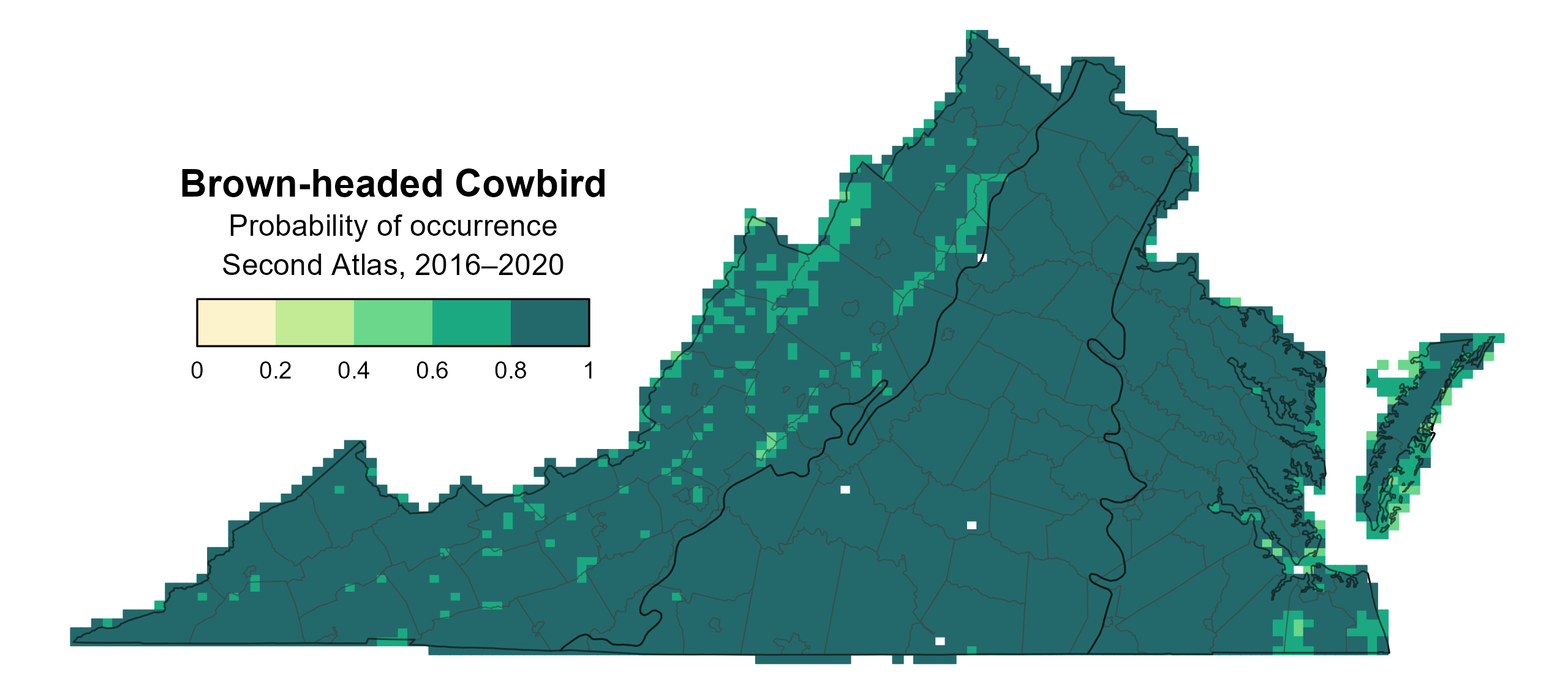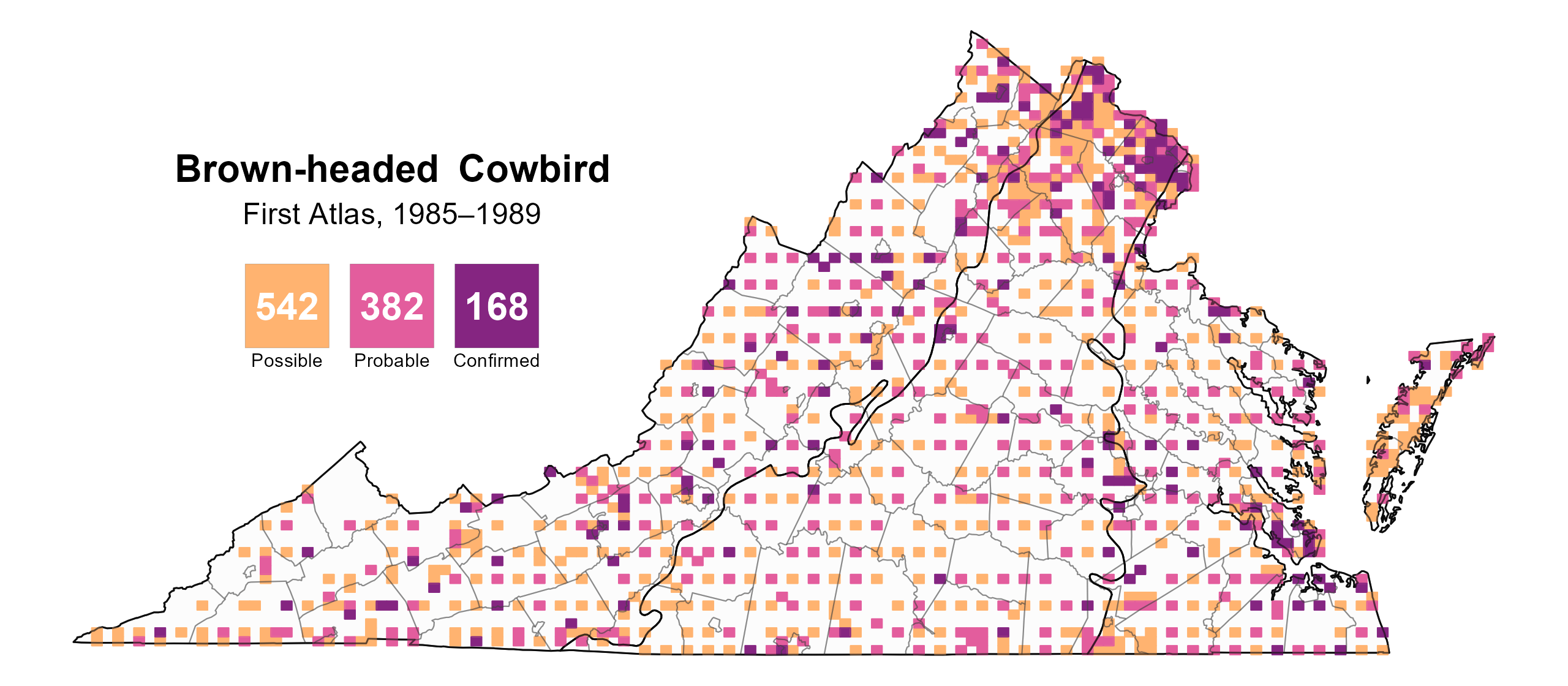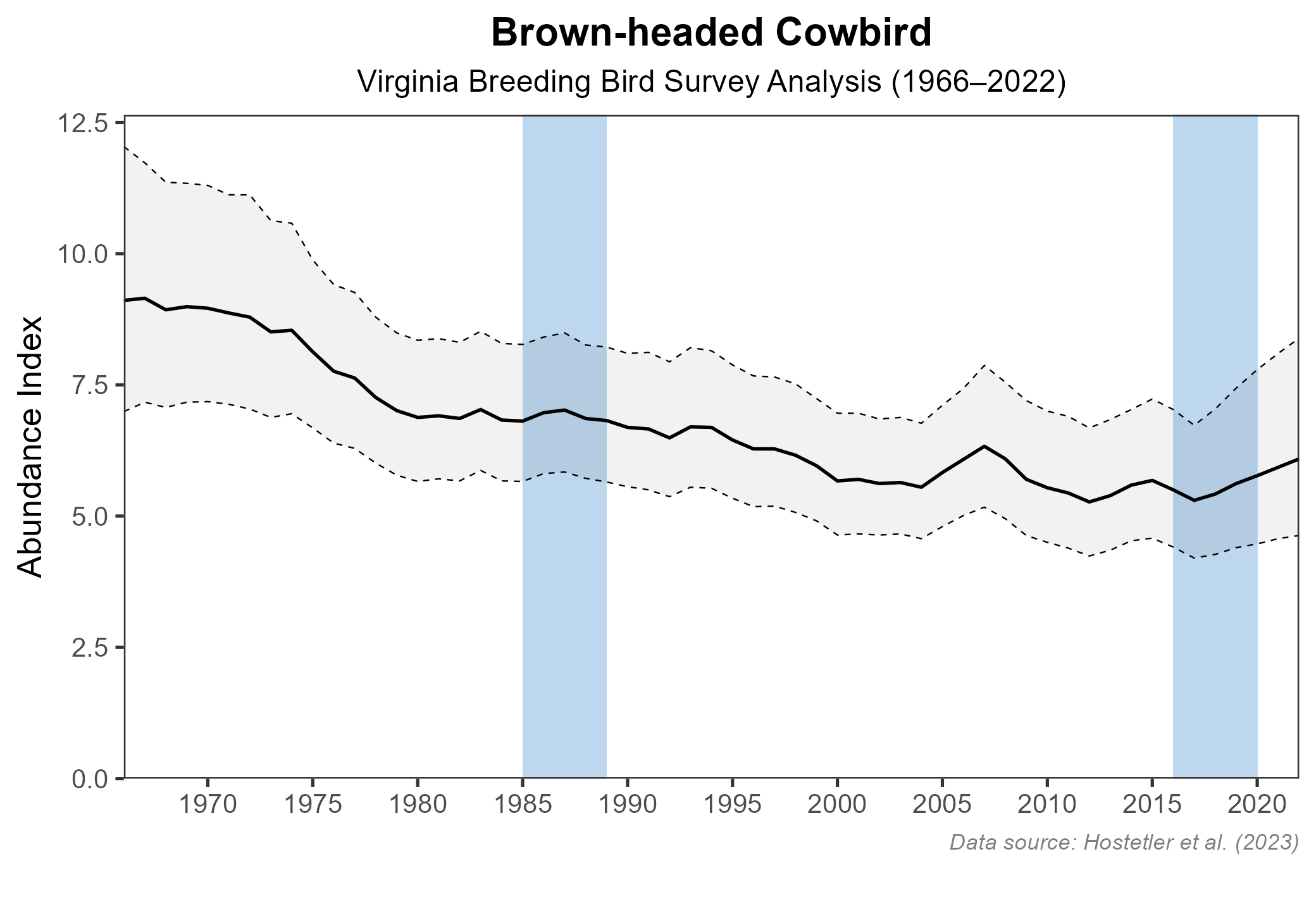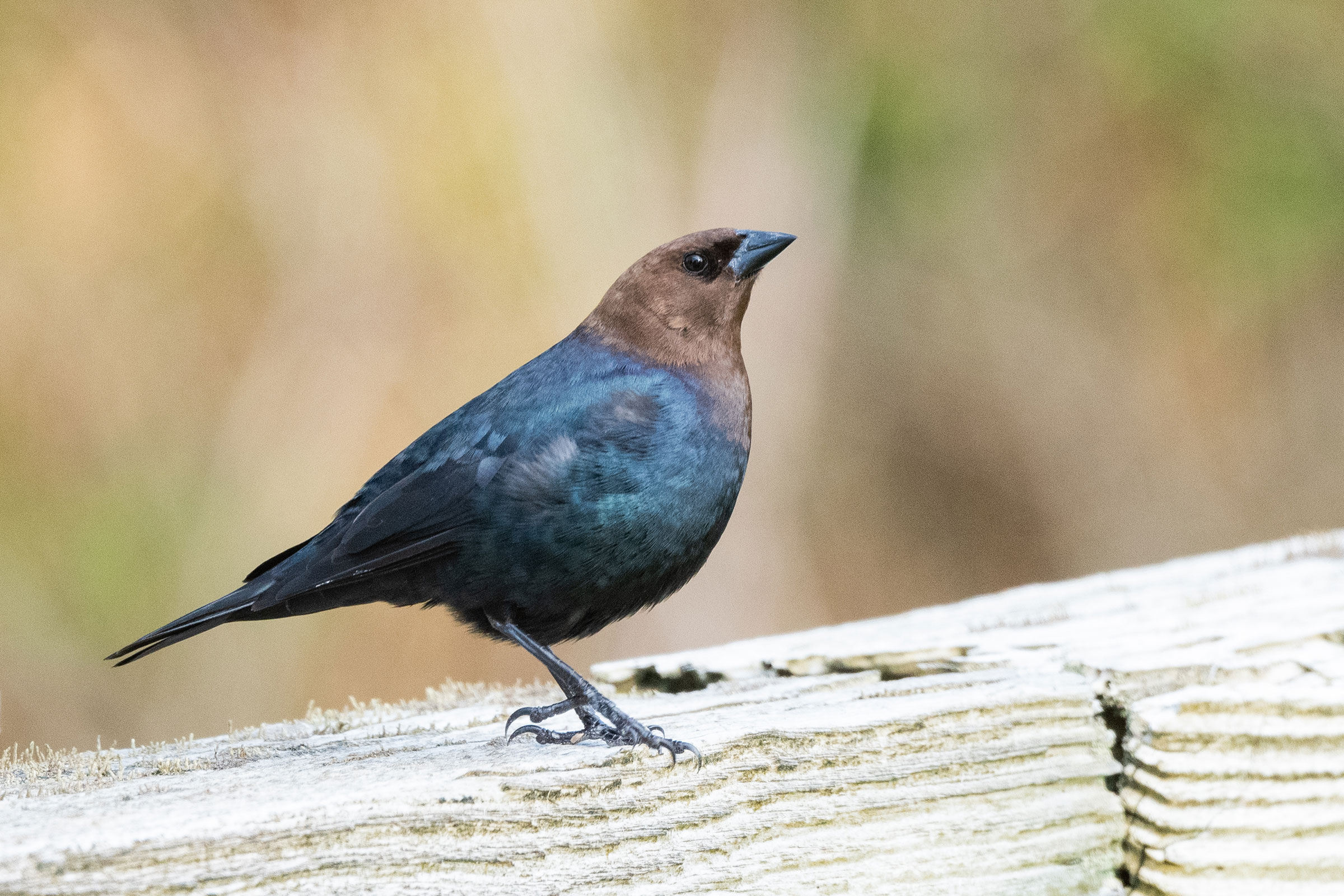Introduction
The Brown-headed Cowbird is one of the most enigmatic species to document for a breeding bird atlas. They are obligate brood parasites, meaning that they lay their eggs in the nests of other birds and depend on them to hatch and raise their young—often to the detriment of these species. Deforestation and habitat fragmentation have resulted in this species substantially expanding its range beyond its pre-colonial distribution, exacerbating the stress it puts on effected species (Chace et al. 2005). The species is known to parasitize the nests of up to 200 species across North America, and in Virginia, during the Second Atlas, the Brown-headed Cowbird was documented parasitizing 48 different breeding bird species.
Breeding Distribution
Brown-headed Cowbirds occur throughout all regions of the state and are only somewhat less likely to occur in the most mountainous areas and coastal zones that remain inundated with sea water (Figure 1). Their likelihood of occurring is slightly positively associated with forest edges; however, these effects are small given the likelihood of Brown-headed Cowbird occurrence is over 40% even at its lowest and is greater than 80% over much of Virginia.
Due to data and model limitations, Brown-headed Cowbird’s distribution during the First Atlas and its change between Atlas periods could not be modeled (see Interpreting Species Accounts). For more information on its distribution during the First Atlas, please see the Breeding Evidence section.

Figure 1: Brown-headed Cowbird breeding distribution based on probability of occurrence (Second Atlas, 2016–2020). This map indicates the probability that this species will occur in an Atlas block (an approximately 10 mi2 [26 km2] survey unit) based on environmental (including habitat) factors and after adjusting for the probability of detection (variation in survey effort among blocks).
Breeding Evidence
Brown-headed Cowbirds were confirmed breeders in 372 blocks and 103 counties and found to be probable breeders in 19 additional counties (Figure 2). Breeding observations were recorded across much of the state, especially near urban areas, which might represent sampling bias, as observer effort is typically higher near human-dominated areas. Confirmed breeders were found throughout the state during the First Atlas as well (Figure 3).
Without nest building behaviors to observe or nests to find, it can be difficult for observers to document evidence of Brown-headed Cowbird breeding. The bulk of evidence comes from observing young Brown-headed Cowbirds that have recently fledged from a host species’ nest (May 15 – August 28) (Figure 4). However, the earliest confirmed breeding behavior was recorded in mid-March when a host’s nest with Brown-headed Cowbird eggs was documented.
For more general information on the breeding habits of this species, please refer to All About Birds.

Figure 2: Brown-headed Cowbird breeding observations from the Second Atlas (2016–2020). The colored boxes illustrate Atlas blocks (approximately 10 mi2 [26 km2] survey units) where the species was detected. The colors show the highest breeding category recorded in a block. The numbers within the colors in the legend correspond to the number of blocks with that breeding evidence category.

Figure 3: Brown-headed Cowbird breeding observations from the First Atlas (1985–1989). The colored boxes illustrate Atlas blocks (approximately 10 mi2 [26 km2] survey units) where the species was detected. The colors show the highest breeding category recorded in a block. The numbers within the colors in the legend correspond to the number of blocks with that breeding evidence category.

Figure 4: Brown-headed Cowbird phenology: confirmed breeding codes. This graph shows a timeline of confirmed breeding behaviors. Tick marks represent individual observations of the behavior.
Population Status
Brown-headed Cowbird relative abundance was estimated to be moderate to high throughout the Piedmont and Coastal Plain regions (Figure 5). It was lower and more variable in the heavily forested Mountains and Valleys region.
The total estimated Brown-headed Cowbird population in the state is approximately 1,248,000 individuals (with a range between 364,000 and 4,408,000). Based on the North American Breeding Bird Survey (BBS), the Brown-headed Cowbird population showed a significant decrease of 0.74% per year from 1966–2022 in Virginia (Hostetler et al. 2023; Figure 6). Between Atlases, BBS data showed a nonsignificant decline of 0.83% per year from 1987–2018.

Figure 5: Brown-headed Cowbird relative abundance (Second Atlas, 2016–2020). This map indicates the predicted abundance of this species at a 0.4 mi2 (1 km2) scale based on environmental (including habitat) factors. Abundance values are presented on a relative scale of low to high.

Figure 6: Brown-headed Cowbird population trend for Virginia as estimated by the North American Breeding Bird Survey. The vertical axis shows species abundance; the horizontal axis shows the year. The solid line indicates the estimated population trend; there is a 97.5% probability that the true population trend falls between the dashed lines. The shaded bars indicate the First and Second Atlas periods.
Conservation
Although they experienced a very slight decline from 1966 to 2022 in the state, Brown-headed Cowbirds are common and widespread in Virginia and throughout their range. They are not considered a species of special concern, and no specific conservation projects are underway in Virginia (Lowther 2020).
Interactive Map
The interactive map contains up to six Atlas layers (probability of occurrence for the First and Second Atlases, change in probability of occurrence between Atlases, breeding evidence for the First and Second Atlases, and abundance for the Second Atlas) that can be viewed one at a time. To view an Atlas map layer, mouse over the layer box in the upper left. County lines and physiographic regional boundaries (Mountains and Valleys, Piedmont, and Coastal Plain) can be turned on and off by checking or unchecking the box below the layer box. Within the map window, users can hover on a block to see its value for each layer and pan and zoom to see roads, towns, and other features of interest that are visible beneath a selected layer.
View Interactive Map in Full Screen
References
Chace, J.T., C. Farmer, R. Winfree, D. R. Curson, W. E. Jensen, C. B. Goguen, and S. K. Robinson (2005). Cowbird (Molothrus spp.) Ecology: A review of factors influencing distribution and abundance of cowbirds across spatial scales. Ornithological Monographs 57:47–70.
Lowther, P. E. (2020). Brown-headed Cowbird (Molothrus ater), version 1.0. In Birds of the World (A. F. Poole and F. B. Gill, Editors). Cornell Lab of Ornithology, Ithaca, NY, USA. https://doi.org/10.2173/bow.bnhcow.01.
Hostetler, J. A., J. R. Sauer, J. E. Hines, D. Ziolkowski, and M. Lutmerding (2023). The North American breeding bird survey, analysis results 1966–2022. U.S. Geological Survey, Laurel, MD, USA. https://doi.org/10.5066/P9SC7T11.




